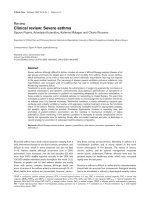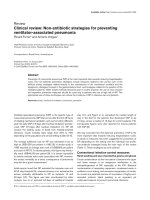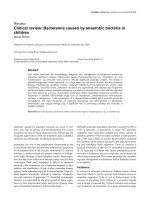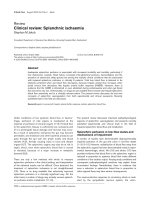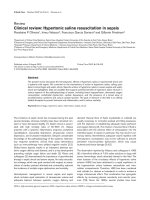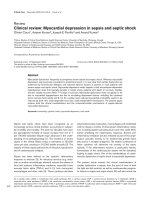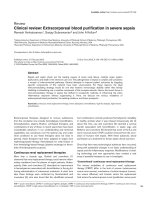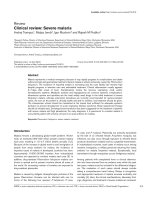Báo cáo y học: "Clinical review: What is the role for autopsy in the ICU" doc
Bạn đang xem bản rút gọn của tài liệu. Xem và tải ngay bản đầy đủ của tài liệu tại đây (158.59 KB, 7 trang )
Introduction
During the past decades, autopsy rates have been
declining worldwide. e non-forensic, clinical autopsy
rate at large hospitals in the United States dropped from
41% in 1964 to 22% in 1975 [1]. In spite of this decline,
the post-mortem examination remains clinically relevant
for time-honoured reasons: the information obtained
helps to understand diseases; it provides essential
feedback for the clinician and leads to quality assessment
and educa tion; and data from it are important for
epidemiologists [2].
We analyzed reports that compare post-mortem cause
of death with clinical diagnosis. e discrepancies
between these two were classifi ed into four categories
according to Goldman’s criteria (Table1) [3]. is article
has the goal of convincing intensivists of the role of
autopsy and gives an overview of the studies performed
in the ICU.
Reasons for the decline in autopsy rate
Costs
e costs for post-mortem analysis cannot be charged to
family members since autopsy fi ndings are irrelevant for
the management of their relative. Hospital administrators
are not easily convinced to spend money on procedures
lacking an immediate impact on patient management
and just for teaching purposes [4,5]. In Belgium, the cost
of an autopsy is estimated at 473 euros and is carried by
the social security system. In London, the cost of one
autopsy is 850 euros when the costs for building a
mortuary are taken into account.
Judicial factors
In the US, some authors claim that the most important
factor explaining the decrease in the autopsy rate is that a
minimum number of autopsies is no longer needed for
accreditation by the Joint Commission on Accreditation
of Hospitals. Some clinicians also seem to be more
reluctant to seek consent out of fear of litigation since
autopsy can reveal missed diagnoses [4].
Communication with patients’ relatives
Because of the growing impact of the opinions of patients
and their relatives, physicians are often forced to discuss
necropsy with them. As a result, the autopsy rate in
France has markedly declined after 1994 (from 15% to
3%), the year that bioethics law impelled physicians to
inform relatives about the performance of a post-mortem
examination [6]. However, it is not clear what the attitude
of relatives is. In a Swedish study, 84% reported accepting
an autopsy for themselves and 80% for a next of kin [7].
In a study performed in a surgical ICU, relatives refused 2
of 27 autopsy requests. Nevertheless, the autopsy rate
was only 25% [8]. is demonstrates that the low autopsy
rate refl ects a low autopsy request rate on the part of
clinicians more than refusal by relatives.
Abstract
The availability of advanced diagnostic tools has grown
in the past decades. Hence, a growing false belief
exists that everything is known about the patient
before death. Moreover, intensivists may wrongly
believe that autopsy ndings do not contribute to
the understanding of pathophysiological events. The
immediate result is that few ICUs nowadays assemble
enough autopsy cases with new and interesting
clinicopathological features. However, we believe
that, at least in tertiary ICUs, autopsies remain a
valuable examination, as a tool for quality control, as
a way of establishing gold standards for diagnostic
examinations and as an aid in developing guidelines
for treatment and diagnosis of diseases frequently
encountered in the ICU. Finally, due to the ever-
expanding armamentarium of immunosuppressive
agents, a growing list of opportunistic infections is
discovered during autopsy. The present article gives an
overview of autopsy studies conducted in the ICU and
discusses the pros and cons of performing these.
© 2010 BioMed Central Ltd
Clinical review: What is the role for autopsy in
theICU?
Greet Yvonne Agnes De Vlieger, Elien Marie Jeanne Lia Mahieu and Wouter Meersseman*
REVIEW
*Correspondence:
Department of General Internal Medicine, Medical Intensive Care Unit, University
Hospital Gasthuisberg, Herestraat 49, 3000 Leuven, Belgium
De Vlieger et al. Critical Care 2010, 14:221
/>© 2010 BioMed Central Ltd
Autopsies are less likely to be performed when not
recommended strongly by the treating physician. In one
study based on physician and surrogate responses, the
expected autopsy rate was 42%, while the actual autopsy
rate was 23% [9]. Training physicians how to recommend
autopsies may increase autopsy rates.
Reluctance of pathologists
Another reason for the decline in autopsy rates is the
growing reluctance of pathologists to perform autopsies.
Several studies analyzing the delay of pathology reports
show a long delay (up to 90 days) [6]. is indicates a lack
of interest in autopsy fi ndings, both from pathologists
and clinicians. e reasons for this are many. First,
pathologists are experiencing an increasing workload.
Secondly, since infectious diseases are rising, pathologists
fear the risk of infection [10]. Finally, autopsies now
contribute little to the scientifi c output of the pathology
department, with only 6% of the published articles being
based on autopsy fi ndings [6].
Modern technology
It can be argued that the sensitivity of modern diagnostic
methods would reduce diagnostic errors to an extent that
autopsies would be unnecessary. However, this reasoning
was not confi rmed by a study by Goldman and colleagues
[3], who studied the time course of diagnostic errors
during the 1960s, 1970s and 1980s and found no
diff erences among the three periods: in all three eras
about 10% of the autopsies revealed a class I missed
diagnosis (Table1).
Analyses of diagnostic error rates, adjusted for case
mix, country and autopsy rate, yielded stable fi gures for
major missed diagnoses throughout the past three
decades [11]. A possible explanation for the stability of
the error rates is increased case selection by clinicians.
Since fewer autopsies are performed, clinically
challenging cases may be more likely to be selected for
autopsy. However, several prospective studies performed
in the 1960s, 1970s and 1980s have shown that clinicians
have a poor ability to identify cases that will yield
‘diagnostic surprises’ [12-14]. A study performed by
Cameron and colleagues [15] showed that 15% of main
diagnoses were not confi rmed by autopsy in cases where
physicians said they would have requested an autopsy.
e rate was similar at 14% in cases where physicians said
they would not have requested an autopsy.
e lack of a decrease in the proportion of missed
diagnoses during the past decades does not indicate a
lack of progress in medical science since the types of
missed diagnoses varied in the diff erent eras [16]. Rather,
it suggests that our clinical and technical investigations
are less sensitive for new disease entities.
Why do autopsies still play an important role in the
ICU?
Autopsies can be used to check the accuracy of existing
diagnostic tools
e imperfect correlation between pre- and post-mortem
fi ndings illustrates that existing diagnostic tools do not
always provide 100% certainty about the existence of a
specifi c disease entity [5]. Autopsies yield important
infor mation on the rates of discrepancies between clini-
cal diagnosis and histology. A few studies investi gating
this have been performed in the ICU. Combes and
colleagues [17] performed the largest, prospective study,
corroborating the results of other studies performed in
the ICU; namely, that the overall type I error rate
averages 10%. A study performed by Roosen and
colleagues [18] with an autopsy rate of 93% revealed that
fungal infection, cardiac tamponade, abdominal haemor-
rhage, and myocardial infarction are the diagnoses most
frequently missed in a medical ICU.
Autopsies allow the accuracy of existing diagnostic
tools to be checked. One example may clarify this matter.
e role of Candida spp. in the airways of critically ill
patients was examined in a prospective, controlled
autopsy study performed in our medical ICU [19]. A
Table 1. Classi cation of discrepancies between pre- and post-mortem diagnoses (according to Goldman and colleagues [3])
Major: important underlying conditions and all primary causes of death
Class I: may have altered therapy or survival
Class II: would not have altered therapy or survival
Minor: unknown preexisting condition not directly related to the cause of death
Class III: would not have altered therapy or survival
Class IV: may have altered therapy or survival
Nondiscrepancy
Class V: complete agreement between clinical and post-mortem diagnosis
Nonclassi able
Class VI: patients died immediately after admission with no diagnostic procedure or refused any diagnostic procedure. Autopsy was unsatisfactory, with no
clear ndings and no diagnosis could be established
De Vlieger et al. Critical Care 2010, 14:221
/>Page 2 of 7
survey by Azoulay and colleagues [20] demonstrated that
24% of French intensivists treat Candida spp. when
found in the airways of mechanically ventilated patients.
However, we did not fi nd Candida pneumonia at autopsy
despite the frequent pre-mortem occurrence of Candida
spp. in the respiratory tract of critically ill patients. is
fi nding argues against the use of expensive antifungal
treatment in mechanically ventilated patients solely on
the basis of isolation of Candida spp. from tracheal
aspirates and broncho-alveolar lavage fl uid. Recent
published guidelines of the Infectious Diseases Society of
America on the treatment of invasive candidiasis in
intensive care reinforce this [21].
Autopsies are useful for understanding pathophysiology
ere are several examples of the value of autopsy in
elucidating pathophysiological mechanisms of disease in
the ICU. Extensive observational data have shown a
consistent, almost linear relationship between blood
glucose levels in hospitalized
patients and adverse clinical
outcomes, even in patients without
established diabetes
[22]. It has never been entirely clear, however,
whether
glycaemia serves as a mediator of adverse outcomes or
merely
as a marker of illness. Several early
studies sug-
gested a clinical benefi t from strict glucose control during
critical illness [23]. Recently, a large multicentre study
called into question the benefi cial fi ndings of tight
glycaemic control [24]. Autopsy might be of help in
elucidating the potential toxic eff ects of hyperglycaemia
on various organs. Vanhorebeek and colleagues [25] used
post-mortem liver samples from the original Leuven
study [23] and showed that mitochondrial function in
hepatocytes was retained in patients with tight glycaemic
control compared to the patients in the conventional treat-
ment group. ere was, however, no diff erential eff ect on
mitochondrial function of myocytes. is autopsy report
could encourage clinicians to perform histological and
molecular studies in order to clarify the mechanisms of
glucose toxicity and to what extent tight glycaemic
control should be achieved.
Autopsies are useful in understanding epidemiology and
describing new disease entities
An illustrative example of the value of autopsy in
explaining certain epidemiological and pathophysio-
logical features of new disease entities is the description
of pathology specimens from patients dying of confi rmed
2009 infl uenza A H1N1 infection. Autopsy studies have
shown that the main pathological changes associated
with 2009 infl uenza A H1N1 infection are located in the
lungs, identifying three distinct histological patterns.
Ongoing aberrant immune responses in lung specimens
could be identifi ed in patients dying of 2009 infl uenza A
H1N1 infection [26]. Also, concurrent bacterial infection
was found in autopsy specimens of 22 of 77 (29%)
patients, including 10 Streptococcus pneumoniae infec-
tions. ese autopsy fi ndings underscore both the
importance of pneumococcal vaccination for persons at
increased risk for pneumococcal pneumonia and the
need for early recognition of bacterial pneumonia in
persons with infl uenza [27].
Autopsies continue to serve as an invaluable educational tool
Due to the ever-expanding armamentarium of immuno-
suppressant and immunomodulating drugs, there is a
growing list of potentially lethal and diffi cult to diagnose
opportunistic infections. Patients with these uncommon
infections often present in an advanced state of their
disease, the conditions of which are often discovered only
post-mortem. e autopsy has an educational role in
describing the histological features of these advanced
disease states and their complications.
Moreover, the autopsy can be an integral part of the
safety analysis of new drugs. Due to detailed brain
autopsies, natalizumab, a novel antibody directed to the
adhesion molecule α
4
integrin, was identifi ed as a risk
factor for development of progressive multifocal leuko-
encephalopathy in patients with Crohn’s disease or
multiple sclerosis treated with this drug [28].
Shojania and colleagues [11] studied the eff ect of
increasing autopsy rate on the incidence of major
diagnostic errors. ey found that major errors decreased
at a rate of 12.4% for every 10% increase in autopsy rate,
and class I errors decreased at a rate of 17.4% for every
10% increase in autopsy rate. is points to the important
educational value of post-mortem examination and we
believe that the decreasing autopsy rate is contrary to
progress in medical diagnostics. We think that medical
students should follow at least some autopsies to
underline the importance of the necropsy.
However, it needs to be stressed that the procedure
needs to be done according to certain criteria and ideally
attended by the intensivist that took care of the patient.
e autopsy has always been a valid monitor of clinical
diagnostic performance if it meets four necessary
conditions, according to Saracci [29]: a high necropsy
rate (28 to 50%); specifi ed and stable conditions under
which necropsies are performed; calculation of sensitivity
and specifi city rather than overall accuracy; and an
estimate of the error in post-mortem diagnoses. Durning
and Cation [30] showed that autopsy cases were
frequently evaluated as a valuable educational experience
by attending physicians.
New, innovative techniques might improve the diagnostic
yield of autopsies
A very intriguing fi eld of interest is molecular investi-
gations at autopsy. Even with normal structural fi ndings,
De Vlieger et al. Critical Care 2010, 14:221
/>Page 3 of 7
molecular analysis of frozen sections can ultimately
resolve ‘unsolved’ cases of sudden death. Ackerman and
colleagues [31] report the results of post-mortem
molecular testing and the identifi cation of a novel muta-
tion in a young woman who died in the ICU after a near-
drowning secondary to what turned out to be a form of
congenital long-QT syndrome. Because of this molecular
fi nding at autopsy, an asymptomatic sibling carrying the
same mutation was able to receive prophylactic
treatment. For sudden cardiac deaths the protocols for
autopsy recommend freezing a piece of spleen for
molecular analysis.
Autopsies might protect physicians from subsequent
malpractice litigation
Among intensivists, the mistaken belief that sophisticated
diagnostic tests have rendered the autopsy obsolete
combined with reluctance to ask bereaved families to
consent to autopsy has substantially reduced interest in
the procedure. Moreover, there is a misperception that
autopsies increase physicians’ exposure to malpractice
claims. Educational eff orts should overcome these barriers
(Table2) [32]. ere must be more attempts to coordinate
autopsies with the schedules of requesting physicians.
Clinicopathological conferences should take place on a
regular (for example, monthly) basis. is means a joint
eff ort of both intensivists and pathologists. e clinicians
need to inform the pathologist about the patient’s
pre-mortem status, the expected fi ndings and the
unsolved questions. e pathologist needs to understand
the importance of the results of autopsy in medical
develop ment. Autopsies can lead to an increased
awareness for rare and emerging diseases and eventually
result in better daily clinical practice.
Information for relatives
e information gained by autopsy fi ndings can help
relatives to understand the cause of death of their loved
ones. Sadly enough, autopsy results are often not
communicated to them. In a study performed by Burton
and colleagues [9], 78% of relatives reported that autopsy
results were not discussed.
Overview of recent studies performed in the ICU
Table 3 lists clinical autopsy studies in the ICU setting.
e amount of major missed diagnoses of class I varied
between 3 and 16%. ere was no signifi cant diff erence in
the type of hospital (referral or general district hospital)
or the type of unit (surgical, medical or mixed). Most of
the studies were retrospective in design, except for the
study by Combes and colleagues [17]. ey prospectively
analyzed autopsies performed on patients who died in a
tertiary care medical-surgical ICU during 3 years. Monthly
clinical-pathological meetings were held to compare
clinical and autopsy diagnoses. During the study, 1,492
patients were admitted, of whom 315 (21%) died during
Table 2. Strategies to improve autopsy rate
E orts by the pathological department
Coordinate autopsies with the schedules of requesting physicians
Faster processing of the autopsy reports
Provision of resources for performing autopsies
Creation of regional autopsy centres
Provides opportunities to improve autopsy quality
Develops strategies for using autopsy results to improve clinical performance
Improvement of training for pathology residents
Better education of medical students
Quality control of performed autopsies (di erent pathologists interpreting the same autopsy specimens) in order to improve diagnostic value
Provide opportunities to improve autopsy quality by specialization
E orts by physicians
Allow physicians complete discretion in requesting autopsies (arbitrary sampling as a result will augment the numbers of important misdiagnoses)
Analyse data from regional centres to identify patterns of missed diagnoses and to generate prediction rules that would enhance the process of case
selection
Augment autopsy numbers with widespread use of structured death reviews and structured reports of epidemiological statistics on various diseases
encountered in the ICU
Communicate the conclusion of the autopsy report to the relatives
E orts by both departments
Clinicopathological conferences on a monthly basis attended by the treating intensivist, the radiologist and the pathologist
Interesting cases should be published with the aim of education and improving knowledge of epidemiology
De Vlieger et al. Critical Care 2010, 14:221
/>Page 4 of 7
their ICU stay and 167 (53%) were autopsied. Clinicians
most frequently erroneously overdiagnosed cancer, endo-
carditis, myocardial infarction and pneumonia. e
intensivist missed 171 diagnoses.
In all studies, infections were most frequently missed.
Medical development has led to new treatments, such as
new cytotoxic agents, and organ and stem cell trans-
plantation, which have led to an increased number of viral
and fungal infections with unusual clinical presen tations
[3,16,33-35]. In a study performed at our medical ICU,
fungal infections occurred in 16% of deceased patients. In
30% of all cases, the diagnosis was not considered pre-
mortem [18]. Veress and Alufuzoff [2] found a signifi cant
increase in infectious diseases in autopsy patients, from
27% in the 1970s to 32% in the 1980s, and an increase in
undiagnosed infections of 30%. Gerain and colleagues [36]
studied the causes of death in oncology patients who died
in an ICU. In 23.5% of all deaths the primary cause was
infectious disease, with fungal disease in 87.5%. Cancer
itself was the direct cause of death in only 10%. Silfvast and
colleagues [37] showed that 62% of class I diagnostic errors
were found in patients with pneumonia or other already
known infec tions. is fi nding emphasises the diffi culty of
diagnosing unexpected or new pathogens in patients with
existing infections.
Pulmonary embolism remains one of the major missed
diagnoses throughout the past three decades (8.9%) [38].
In autopsied patients who died from pulmonary
embolism, the diag nosis was unsuspected in 14 of 20
(70%). Most of these patients had advanced associated
disease [38]. As Gold man postulates, the persistent high
rate of missed pulmo nary embolism is more a refl ection
of the high mortality of the pathology when this diagnosis
is missed [35]. e availability of new diagnostic
techniques can also give misleading information. e
frequency of a false-positive diagnosis of pulmonary
embolism (when the clinician ascribed the death to
pulmonary embolism not confi rmed at autopsy) rose
from 33% in 1959 to 44% in 1999/2000 [39].
Intra-abdominal and retroperitoneal bleeding and
more general acute abdominal complications are under-
diagnosed in the ICU. Altered mental status, narcotic
medication, immunosuppression and mechanical ventila-
tion make the bedside diagnosis diffi cult. Angiography or
computed tomography are often not an option in these
unstable patients and bedside ultrasound is frequently
inconclusive. Papadakis and colleagues [40] studied the
diagnostic discrepancy in veteran soldiers receiving
mechanical ventilation. irty-nine percent of the class I
errors were potentially treatable abdominal disorders. In
two-thirds, the errors arose because clinicians failed to
consider the diagnosis, and not because the clinicians
had misleading or inconclusive information from
diagnostic procedures.
Conclusion
Over the past decades, autopsy rates have been declining
and studies on autopsy fi ndings are scarce. We are
Table 3. Overview of recently performed autopsy studies in the ICU setting
Autopsy Number Major Class I
Studied Type of Study rate of error
†
error
Author Period population hospital* design (%) autopsies (%) (%)
Roosen et al. [18] 1996 Medical Referral, Belgium Retrospective 93 100 36 16
Combes et al. [17] 11/1995 to 10/1998 Mixed Referral, France Prospective 53 167 31.7 10.2
Dimopoulos et al. [41] 1999 Mixed Referral, Belgium Retrospective 45 222 8.5 5.4
Maris et al. [42] 1/2004 to 12/2005 Mixed Referral, Belgium Retrospective 37 289 19 6
Nadrous et al. [33] 1/1998 to 12/2000 Mixed Referral, USA Retrospective 33 455 21 4
Tai et al. [16] 1/1994 to 12/1995 Medical Referral, USA Retrospective 22 91 19.78 8.79
Mort et al. [43] 7/1986 to 7/1992 Surgical Referral, USA Retrospective 29 149 23 9.5
Podbregar et al. [44] 1/1998 to 12/1999 Medical Referral, Slovenia Retrospective 46 126 52.4 12
Twigg et al. [45] 6/1996 to 5/1999 Mixed District, UK Retrospective 40 97 23.71 4.12
Silfvast et al. [37] 1/1996 to 12/2000 Mixed Referral, Finland Retrospective 89 346 5 2.3
Fernandez-Segoviano 5/1983 to 12/1985 Mixed Referral, Spain Prospective 51 100 22 7
et al. [46]
Pastores et al. [34] 1/1999 to 9/2005 Oncologic Referral, USA Retrospective 13 86 26 17
Ong et al. [47] 1/1997 to 12/1998 Trauma and burns Referral, USA Retrospective 97 153 18.95 3
Al-Saidi et al. [48] 11/1994 to 6/1999 Bone marrow Referral, Canada Retrospective 47 28 10.7 3.6
transplant
Gerain et al. [36] 11/1985 to 10/1986 Oncologic Referral, Belgium Retrospective 69 34 59 Unknown
*Referral: a hospital that is linked to a university, deals with general admissions and with referrals from other hospitals.
†
Major error: class I or II according to Goldman’s
criteria of missed diagnoses [3].
De Vlieger et al. Critical Care 2010, 14:221
/>Page 5 of 7
convinced that the performance of necropsy is necessary
for many reasons. First, studies have shown that despite
technical improvements, the frequency of missed
disorders has not diminished compared to the 1960s and
1970s. e reason is the advent of several new pathologies
with more opportunistic infections in an era of HIV and
infl uenza A H1N1 pandemics, new immunosuppressive
treatments for transplant recipients and auto-immune
diseases. Second, we argue that the post-mortem exami-
na tion can be useful for relatives, especially if the cause of
death is not clear. We regret the fact that autopsy results
are often not reported to the relatives. Moreover,
clinicians and pathologists do not communicate well with
each other. Input from the clinician can motivate the
pathologist to fi nd new, rare or unsuspected diseases.
e costs of post-mortem examination are negligible
compared to the overall costs of ICU stay. Since the
results may improve our daily practice, we should not
consider the costs as a reason to forestall autopsies.
We ask that the importance of post-mortem examina-
tions be reconsidered, since autopsy remains the ultimate
tool of accountability for clinical evaluation and manage-
ment of new and old diseases.
Competing interests
WM reports receiving a grant from P zer for investigational research in fungal
diseases.
Authors’ contributions
GDeV, EM and WM contributed equally in developing the design and concept
of the article. GDeV and EM wrote the article and WM critically reviewed the
article and made some changes. The authors have no nancial interest in this
article.
Acknowledgements
We thank Professor Dr S Vanderschueren for thoroughly reading the article
and giving additional suggestions.
Published: 28 May 2010
References
1. Roberts WC: The autopsy: its decline and a suggestion for its revival. N Engl
J Med 1978, 299:332-338.
2. Veress B, Alufuzo I: A retrospective analysis of clinical diagnoses and
autopsy ndings in 3,042 cases during two di erent time periods. Hum
Pathol 1994, 25:140-145.
3. Goldman L, Sayson R, Robbins S, Cohn L, Bettmann M, Weisberg M: The value
of the autopsy in three medical eras. N Engl J Med 1983, 308:1000-1005.
4. Esteban A, Fernández-Segoviano P: The autopsy as a tool to monitor
diagnostic errors. Intensive Care Med 1999, 25:343-344.
5. Estaban A, Fernández-Segoviano P: Is autopsy dead in the ICU? Intensive
Care Med 2003, 29:522-525.
6. Chariot P, Witt K, Pautot V, Porcher R, Thomas G, Zafrani ES, Lemaire F:
Declining autopsy rate in a French hospital: physician’s attitudes to the
autopsy and use of autopsy material in research publications. Arch Pathol
Lab Med 2000, 124:739-745.
7. Sanner MA: Comparison of public attitudes toward autopsy, organ
donation and anatomic dissection. A Swedish survey. JAMA 1994,
271:284-288.
8. Mosquera D, Goldman M: Surgical audit without autopsy: tales of the
unexpected. Ann R Coll Surg Engl 1993, 75:115-117.
9. Burton E, Phillips R, Covinsky K, Sands L, Goldman L, Dawson N, Connors A,
Landefeld C: The relation of autopsy rate to physicians’ beliefs and
recommendations regarding autopsy. Am J Med 2004, 117:255-261.
10. Lemaire F: Should the autopsy be resuscitated? Intensive Care Med 2003,
29:518-521.
11. Shojania KG, Burton EC, McDonald KM and Goldman L: Changes in rates of
autopsy-detected diagnostic errors over time. JAMA 2003, 289:2849-2856.
12. Heasman MA, Lipworth L: Accuracy of Certi cation of Cause of Death. London,
England: Her Majesty’s Stationery O ce; 1966.
13. Britton M: Diagnostic errors discovered at autopsy. Acta Med Scand 1974,
196:203-210.
14. Cameron HM, McGoogan E:
A prospective study of 1152 hospital
autopsies, I: inaccuracies in death certi cation. J Pathol 1981, 133:273-283.
15. Cameron HM, McGoogan E, Watson H: Necropsy: a yardstick for clinical
diagnoses. Br Med J 1980, 281:985-988.
16. Tai DH, El Bilbessi H, Tewari S, Mascha EJ, Wiedemann HP, Arroliga AG: A study
of consecutive autopsies in a medical ICU. A comparison of clinical cause
of death and autopsy diagnosis. Chest 2001, 119:530-536.
17. Combes A, Mokhtar M, Couvelard A, Trouillet J, Baudot J, Hénin D, Gilbert C,
Chastre J: Clinical and autopsy diagnoses in the intensive care unit. Arch
Intern Med 2004, 164:389-392.
18. Roosen J, Frans E, Wilmer A, Knockaert D, Bobbaers H: Comparison of
premortem clinical diagnoses in critically ill patients and subsequent
autopsy ndings. Mayo Clin Proc 1999, 27:299-303.
19. Meersseman W, Lagrou K, Spriet I, Maertens J, Verbeken E, Peetermans WE,
Van Wijngaerden E: Signi cance of the isolation of candida species from
airway samples in critically ill patients: a prospective autopsy study.
Intensive Care Med 2009, 35:1526-1531.
20. Azoulay E, Cohen Y, Zahar J, Garrouste)Orgeas M, Adrie C, Moine P, de
Lassence A, Timsit J: Practices in non-neutropenic ICU patients with
Candida-positive airway specimens. Intensive Care Med 2004, 30:1384-1389.
21. Pappas P, Kau man C, Andes D, Benjamin D, Calancra T, Edwards J, Filler S,
Fisher J, Kulleberg B, Ostrosky-Zeichner L, Reboli A, Rex J, Walsh T, Sobel J:
Clinical practice guidelines for the management of candidiasis: 2009
update by the Infectious Diseases Society of America. Clin Infect Dis 2009,
48:503-535.
22. Comi RJ: Glucose controle in the intensive care unit: a roller coaster ride or
a swinging pendulum? Ann Intern Med 2009, 150:809-811.
23. Van den Berghe G, Wouters P, Weekers F, Verwaest C, Bruyninckx F, Schetz M,
Vlasselaers D, Ferdinande P, Lauwers P, Bouillon R: Intensive insulin therapy
in the critically ill patients. N Engl J Med 2001, 345:1359-1367.
24. Finfer S, Chittock D, Su S, Blair D, Foster D, Dhingra V, Bellomo R, Cook D,
Dodek P, Henderson W, Hébert P, Heritier S, Heyland D, McArthur C,
McDonald E, Mitchell I, Myburgh J, Norton R, Potter J, Robinson B, Ronco J:
Intensive versus conventional glucose control in critically ill patients.
NEng J Med 2009, 360:1283-1297.
25. Vanhorebeek I, De Vos R, Mesotten D, Wouters P, De Wolf-Peeters C, Van den
Berghe G: Protection of hepatocyte mitochondrial ultrastructure and
function by strict blood glucose controle with insulin in critically ill
patients. Lancet 2005, 354:53-59.
26. Mauad T, Hajjar L, Callegari G, da Silva L, Schout D, Galas F, Alves V, Melheiros
D, Auler J, Ferreira A, Borsato M, Bezerra S, Gutierrez P, Caldini E, Pasqualucci C,
Dolhiniko M, Saldiva P: Lung pathology in fatal novel human in uenza A
(H1N1) infection. Am J Respir Crit Care Med 2009, 181:72-79.
27. Centers for Disease Control and Prevention: Bacterial coinfections in lung
tissue specimens from fatal cases of 2008 pandemic in uenza A (H1N1)
- United States, May-August 2009. MMWR Morb Mortal Wkly Rep 2009,
[ />28. Van Assche G, Van Ranst M, Sciot R, Dubois B, Vermeire S, Noman M, Verbeeck
J, Geboes K, Robberecht W, Rutgeerts P: Progressive multifocal
leukoencephalopathy after natalizumab therapy for Crohn’s disease.
NEngl J Med 2005, 353:362-368.
29. Saraci R: Is necropsy a valid monitor of clinical diagnosis performance?
BrMed J 1991, 303:898-900.
30. Durning S, Cation L: The educational value of autopsy in a residency
training program. Arch Intern Med 2000, 160:997-999.
31. Ackerman M, Tester D, Porter C, Edwards W: Molecular diagnosis of the
inherited long-QT syndrome in a woman who died after near-drowning.
NEng J Med 1999, 341:1121-1125.
32. Shoj ania K, Burton E: The vanishing nonforensic autopsy. N Engl J Med 2008,
358:873-875.
33. Nadrous HF, Afessa B, Pfeifer E, Peters SG: The role of autopsy in the
intensive care unit. Mayo Clin Proc 2003, 78:947-950.
34. Pastores S, Dulu A, Voigt L, Raoof N, Alicea M, Halpern N: Premortem clinical
De Vlieger et al. Critical Care 2010, 14:221
/>Page 6 of 7
diagnoses and postmortem autopsy ndings: discrepancies in critically ill
cancer patients. Crit Care 2007, 11:R48.
35. Goldman L: Diagnostic advances - the value of the autopsy. 1912-1980.
Arch Pathol Lab Med 1984, 108:501-505.
36. Gerain J, Sculier JP, Malengeaux A, Ryckaert C, Thémelin L: Causes of deaths
in an oncologic intensive care unit: a clinical and pathological study of 34
autopsies. Eur J Cancer 1990, 26:377-381.
37. Silfvast T, Takkunen O, Kolho E, Andersson L, Rosenberg P: Characteristics of
discrepancies between clinical and autopsy diagnoses in the intensive
care unit: a 5-year review. Intensive Care Med 2003, 29:321-324.
38. Stein PD, Henry JW: Prevalence of acute pulmonary embolism among
patients in a general hospital and at autopsy. Chest 1995, 108:978-981.
39. Kirch W, Shapiro F, Fölsch UR: Health care quality: misdiagnosis at a
university hospital in ve medical eras. J Public Health 2004, 12:154-161.
40. Papadakis MA, Mangione CM, Lee KK, Kristof M: Treatable abdominal
pathologic conditions and unsuspected malignant neoplasms at autopsy
in veterans who received mechanical ventilation. JAMA 1991, 20:885-887.
41. Dimopoulos G, Piagnerelli M, Berré J, Salmon Z, Vincent J-L: Post mortem
examination in the intensive care unit: still useful? Intensive Care Med 2004,
30:2080-2085.
42. Maris C, Martin B, Creteur J, Remmelink M, Piagnerelli M, Salmon I, Vincent J-L,
Demetter P: Comparison of clinical and post-mortem ndings in intensive
care unit patients. Virchows Arch 2007, 450:329-333.
43. Mort TC, Yeston NS: The relationship of pre-mortem diagnoses and post-
mortem ndings in a surgical intensive care unit. Crit Care Med 1999,
27:299-303.
44. Podbregar M, Voga G, Kirved B, Skale R, Pareznik R and Gabrscek L: Should we
con rm our clinical diagnostic certainly by autopsies? Intensive Care Med
2001, 27:1750-1755.
45. Twigg S, McCrirrick A, Sanderson P: A comparison of post mortem ndings
with post hoc estimated clinical diagnoses of patients who die in a United
Kingdom intensive care unit. Intensive Care Med 2001, 27:706-710.
46. Fernández-Segviano P, Lázaro A, Estaban A, Rubio JM, Iruretagoyena JR:
Autopsy as quality assurance in the intensive care unit. Crit Care Med 1988,
16:683-685.
47. Ong A, Cohn S, Cohn K, Jaramillo D, Parbhu R, McKenney M, Barquist E, Bell M:
Unexpected ndings in trauma patients dying in the intensive care unit:
results of 153 consecutive autopsies. J Am Coll Surg 2002, 194:401-406.
48. Al-Saidi F, Diaz-Granados N, Messner H, Herridge M: Relationship between
premortem and postmortem diagnosis in critically ill bone marrow
transplantation patients. Crit Care Med 2002, 30:570-573.
doi:10.1186/cc8925
Cite this article as: De Vlieger GYA, et al.: Clinical review: What is the role for
autopsy in the ICU? Critical Care 2010, 14:221.
De Vlieger et al. Critical Care 2010, 14:221
/>Page 7 of 7
